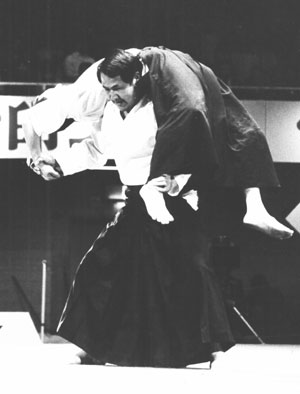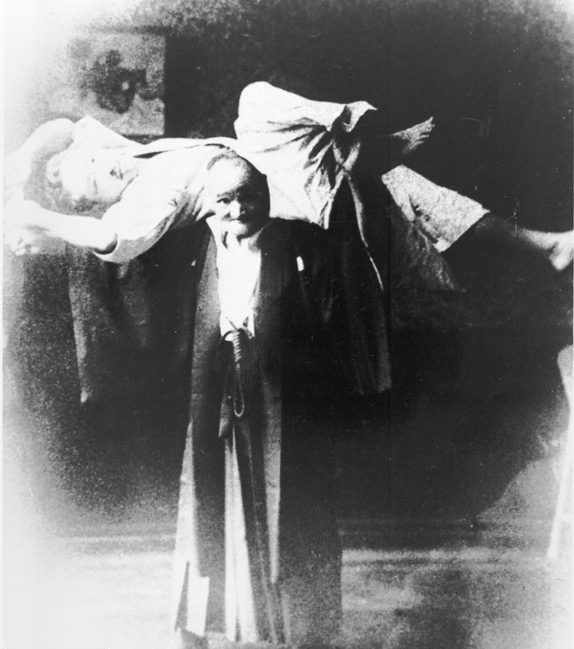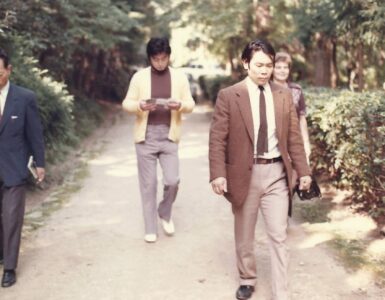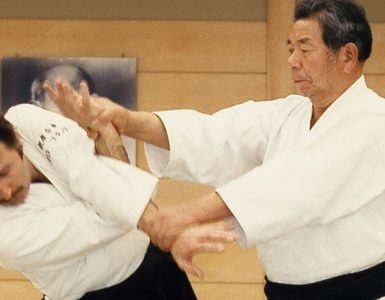“A doctored photo? What do you think?”
Take a look at this highly unusual photo of Sokaku Takeda, disseminator of Daito-ryu jujutsu and teacher of Morihei Ueshiba. First, allow me to provide some background information. This photo was taken about 1939 in Osaka, probably at the Asahi News dojo, during the period when Sokaku was teaching Daito-ryu to employees of the newspaper.
The Asahi dojo had an interesting background. Its first instructor was none other than Morihei Ueshiba from 1933-1936, and then Sokaku Takeda from 1936-1939. Sokaku took over instruction duties at the Asahi dojo under rather strange circumstances. Several of the few surviving photos of Sokaku were taken in Osaka because the trainees had access to the facilities and equipment of the newspaper, one of Japan’s largest.
Now let’s examine the photo itself. Sokaku has raised a student onto his shoulders prior to executing a twisting throw characteristic to Daito-ryu. The photo appears posed as Sokaku is stiff-legged and standing still. Also, notice that the body of the student appears to be supported by Sokaku’s outstretched arms. Sokaku’s extended right arm is clearly visible while his left hand seems to be supporting the student’s right leg. But perhaps the most condemning detail is the fact that the student is gazing leisurely into the camera and seems quite undistressed in this position. Believe me, if Sokaku were actually applying the technique, uke would be in extreme pain!

The odd part of the photo is that the student’s body appears rigid as if supported by something beneath him other than Sokaku’s extended arms. Is there a platform of some sort being used to allow Sokaku to hold this position for the time necessary to frame and shoot the photo? Is Sokaku aware of all that is going on and cooperating in a staged event? It seems out of character for this to be the case. It’s certainly a tantalizing subject and probably one we’ll never find an answer to.
Realize, too, that at this point in time Sokaku has given out the only two Daito-ryu Menkyo Kaiden to two Asahi News dojo members: Takuma Hisa and Masao Tonedate. This represents a break from historical precedent within this famous jujutsu school. It seems that the Menkyo Kaiden certification did not exist in the Daito-ryu tradition prior to this time.
We know that Sokaku considered the Asahi dojo to be important and an excellent means of extending his reach to a larger audience due to the considerable means and influence of the newspaper. Was he perhaps convinced of the desirability of awarding such a diploma to Asahi members to benefit the art, or perhaps in some way rewarded?
In any event, let me invite Aikido Journal readers to have a close look at the photo and give us your take on what may have actually transpired at the time this rare image was taken.
Have fun!
Stan













IMO, it is fake. First clue is the heads; they just seam out of proportion. Uke’s head looks much larger than Takeda’s – like Uke was closer to the camera than Takeda when their picture was taken. Also, I can not see any clear lines of demarcation where the two are touching; just looks like they meld into each other. So, IMO, it is not just a faked scene, but a doctored picture as well.
I don’t think its faked. First of all, there is no point in faking the shot, and it is definetly out of character for Sokaku Takeda, the great mighty grand master of daito ryu to do so. Even though at this time Takeda was realy old and had lost lot of his physical strengh, I don’t think he wouldn’t lift that particular fellow for a quick shot, since he doesn’t seem heavy and tall, and this lift doesn’t require much strength because of the total support by the hips, and it seems Sokaku slightly modified the technique for the purpose of taking the picture. He just holds lightly the hand and the cuff letting his opponent rest on his arm and shoulders, instead of rigid grip with applied force to bend the opponent around the shoulders as we can see in example of Kondo sensei. That’s why the opponents face is calm. He is not in pain, even if he would feel some pain I think he would hold it and because he is turned to the camera he would want to show a natural face instead of distorted in pain and hardly recognisable. After all, he is posing with the martial arts legend. Yep, Sokaku does feel the pressure on his shoulders, please look closely at his face.
It certainly appears staged, if not superimposed. The comparison with Kondo Sensei is telling. Interesting point about the leg. Saito Sensei in the aikido style of gansekki-otoshi took his partners out at the knees. I always thought that if you weren’t being nice you’d go up between the legs, but these pictures put, pun intended, a new twist on things.
Faked? Probably not, but certainly posed – just like most technical pictures from that era. Mostly a limitation of the camera equipment available then.
On a similar note Tobin E Threadgill offers the following comment on Facebook:
“As a professional photographer and an advisory board member at the Brooks Institute of Photography i get a bit irritated when people with scant knowledge of photography or photo history start using words like “faked” or “doctored” without the context to understand what they’re looking at.. Staged would be a much better description. In the early era of photography photos were commonly staged to represent something impossible to catch with the technology of the day. Without high speed films, large maximum apertures or powerful flash photography shooting photos of action were simply impossible. Using the word faked implies an attempt to mislead. If the photo in question was staged why does one automatically assume an intent to mislead? Such a claim in my opinion is irresponsible muckraking that ignores realities of that day and age.”
HI Stan. The history of this image is documented in the book “Transparent Power” by Tatsuo Kimura sensei (page 215 in the English version).
The uke in the image is the younger brother of Yukiyoshi Sagawa sensei, called Hiroshi Sagawa.
In the book, Hiroshi sensei demonstrates the “katsugi waza” (shoulder technique) on Kimura sensei.
Input much appreciated.
Staged without a doubt…Sokaku wanted a nice shot of himself and so it was done…Sokaku’s skill’s were real so one posed shot really is no big deal.
I believe Mr.Threadgill gives the best interpretation.
The impatient look on Mr Takeda’s face and that of the uke suggest one of them just thought, if not said, “Is this pose OK? So hurry up with those dam gadgets, I can’t stay like this all day..”
He was probably also thinking, “I can still do it at my age but what a bore just to show off for posterity. Hope it turns out after all this histrionics ..”
Slow aperture speed and lots of fiddling, they would have had to hold the position if not repeat several takes.
I’ve seen it before, and something looks wrong but I can’t say what. Before your article on the photo of O Sensei in front of the “changing” scroll it didn’t occur to me such things as doctoring was done. In my understanding, a rapid throw couldn’t be captured by photographic equipment at the time so there would be at least a pausing for the pose. Uke does not appear to be under any momentum – the material of both Gi are hanging and not moving. The throw is not identical to what is shown with Kondo Sensei – Kondo is grabbing the wrist and ankle of his uke, Takeda Sensei looks to be holding a pant leg with one arm and the uke is gripping some sort of stick? A type of tantonage? That would mean the Uke’s joints would be under much less pressure and torque, so less pain and more mobility.
None of this can detract from Takeda’s genuine ability. The posing done is similar to “Budo” which suffered from the same deficits in photographic technology.
History repeats cause human nature and ways to act in society does not change too much with time essencially. That is why we can read books like the Bible, and the Classics as manuals for solve present situations. The Iching Book is another big proof of this fact.
A Sage said : “There is nothing new under the Sun”.
This explains many things mentioned in the article.
There is a book published by Stan where Takuma Hisa explains a lot about how Sokaku Takeda started teaching in the Asahi Dojo. It is a very interesting report.
About the photo, probablly that time they did not had like today phograph machines that shot a lot of photos in a sequence like we have today.
Of course it would be very difficult that time to a photographer catch the exact best moment of the technnique, so they posed in the best moment. Unfortunatelly they did not knew the best way to do it and have a better effect.
Anyone that has experience in Aiki seen this photo can immidiatelly feel that the “ki” is not circulating , specially because the uke looks like if he was in a beach resting beeing carried by a slave. Butt also Sokaku Takeda clearlly shows that that is “suffering” to carry such a heav load in his back and sustain it in that position.
What was lacking in my view in this photo was a good “director of art” to assist then , that would understand about Aiki tecnique to instruct uke how to behave and also check Sokaku Takeda position giving a certain “movement”.
Anyway for a man in that age is suprisingTakeda Sokaku can carry that heavy load on his back, I take my hat to him.
Professional Martial Arts teaching is a kind of bussiness, that needs propaganda, good reputation and of course, produces sufficient rewards.
It is a mistake, to compare things done on a professional basics with other done with love and passion.
That is why it is much more better in a war to have 300 patriots on his side like had the King Leonidas from the ancient Greek city of Sparta then thousants persian Merceneraies leaded by King Dario.
This , I believe should be a question any student should do for himself when he has to choose a Aikido instructor.
Of course there is not problem to make money teaching martial arts, but this must be secondary otherwise it is impossibel to really transmit aiki once it commes from the deep of our heart and this requires sincerity and abandon of the Ego and selfish interests. This is very difficult to do when we start a bussiness.
That is why montly fee one pay in one dojo can not be seen as a “payment for services” but as a “offer in gratitude ” to the sensei.
Of course it is important to check how the “sensei” is receiving it in fact.
Wagner Bull
I thing nobody here know this technique, or is able to do it. This picture don’t need to be a fake, because this technique, if you know how to do, is very easy to do. Uke is not pain because simply if you do this technique sofly, It is no pain for Uke (shur It is surprising but very pleasant technique : to do, and to undergo (in the way of training I say). I have pictures of similaires technique I take by my self of Kobayashi Sensei for exemple (Takumagaï) and It is absolutly similaire at the picture of Takeda Sokaku. But the technique of Kondo Sensei is not similaire (just see his hands and you will understand what is différent) : It is the same technique but the technique of Kondo Sensei is the imperioius version. It is the same technique but not do with the same purpose… and not in the same way to do.
Olivier Gaurin
In support of Toby’s observation regarding the photograph being “staged’ as opposed to “faked” or “doctored”, there appears to be a portion of a chair or perhaps a short stepladder in the right edge of the photograph. Just a thought.
“By definition, any portrait is staged or faked! People are asked to stand a certain way, lighting is manipulated, timing is made up, etc. All fake. Nothing spontaneous, real, authentic, on the spot capturing of a real event as it actually happens.
On this basis the word “faked” does not carry any malicious connotations at all. Who is being misled? Everyone can look and draw their own conclusion. The title evoked a response. It did its job to capture attention. The article per se contained no “muckraking” at all. It posed some valid questions, using freedom of speech to evoke freedom of thought. Sensible people responded with sincerity at the front door and not obliquely. What a lovely thing.
Even in the case of cinéma vérité or reportage by definition is fake. The only authentic shot would be raw footage in battlefield. (Even then, the bulk of what has been published since WW1 turned out to be faked for propaganda purposes purposes.)”
Yup, it was, and is a doctored photo.
The proportions are wrong, and all that Stan pointed out.
Fun anyway, what!
The technique as executed in the photo has Uke lying on his back. Another way of executing the technique is to load uke “sidewards” on their hip. This keeps them rigid and makes them lighter.
You can see this in this photo:
http://www.muden.jp/aiki/wp-content/uploads/2011/03/iida_P031.jpg
I am the Uke. I’m 5 ft 10 inches (175 cm) and weigh about 72 kilograms.
My instructor performing the technique is about 5 ft 3 inches and was well into his sixties at the time of the photo, so doing the technique at an fairly advanced age is perfectly possible.
As an edit to the previous post:
For those considering playing with this technique from the photos and descriptions on this thread:
This technique is extremely dangerous and should ONLY be practiced under the supervision of a qualified Daito Ryu instructor.
Doing this technique incorrectly can lead to serious injury for both Uke and Tori.
Hi!
It would be better to have the picture presented above the article without the title across.
Thank you anyway !!!
This technique is a variation of Kata Guruma and is not difficult to perform at all, if you have a fairly strong background in Daito Ryu Jujutsu or any of its many closely related branches.This is 100% real photo and if anyone could perform this waza and look effortless it is this amazing man OSensei Soke Sokaku Takeda without a doubt.
After I got shodan in Aikido in Osaka, under Kobayashi, in 1974, I went to Abashiri to visit and practice in the Takeda dojo. Takeda Sogaku’s son, then an old man, was teaching. They gave me an anniversary pamphlet, which I still have, that shows the son, as a young man, doing that same throw. The person on the shoulders look’s stiff and straight as in the photo of Sogaku senior’s throw that is being disputed. As everyone who does Aikido knows, there is a choreography to Aikido, and the person being thrown usually over-cooperates with the person doing the throw. It could be that in the practice of this technique, people train to keep their body’s straight and stiff. I could send an image of the photo in the anniversary pamphlet if someone gives me an email address to send to.